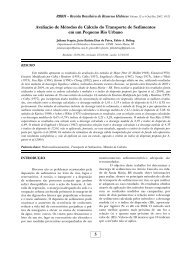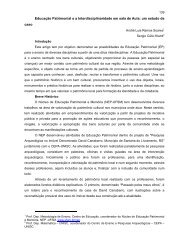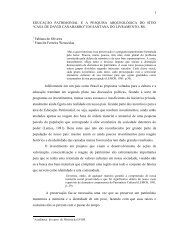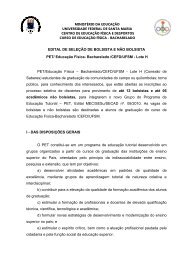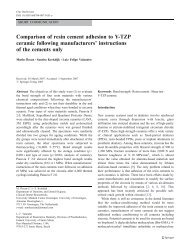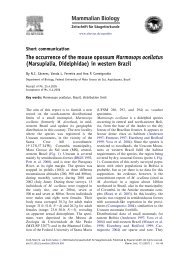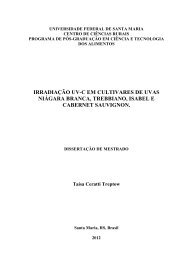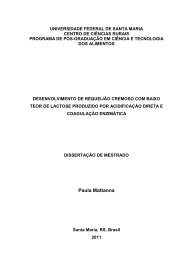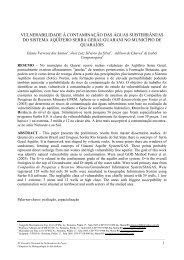Estudo da Hidrodinâmica de Colunas Pulsadas Aplicada ao - UFSM
Estudo da Hidrodinâmica de Colunas Pulsadas Aplicada ao - UFSM
Estudo da Hidrodinâmica de Colunas Pulsadas Aplicada ao - UFSM
You also want an ePaper? Increase the reach of your titles
YUMPU automatically turns print PDFs into web optimized ePapers that Google loves.
como citado por GOTTLIEBSEN et al. (2000),<br />
quanto às exigências <strong>ao</strong> tamanho excessivo <strong>da</strong>s<br />
seções <strong>de</strong> coalescência <strong>da</strong> coluna.<br />
V d+V c(x d/1-x d)<br />
0,20<br />
0,16<br />
0,12<br />
0,08<br />
0,04<br />
0,00<br />
y = 1,5477x<br />
y = 1,0526x<br />
y = 0,7976x<br />
y = 0,5839x<br />
0,00 0,05 0,10 0,15 0,20<br />
x d(1-x d)<br />
f = 0,50 Hz f = 0,75 Hz f = 1,00 Hz f = 1,25 Hz<br />
Figura 5 – Determinação gráfica <strong>da</strong> veloci<strong>da</strong><strong>de</strong><br />
característica (A= 0,8 cm).<br />
Tabela 2 – Veloci<strong>da</strong><strong>de</strong>s <strong>de</strong> inun<strong>da</strong>ção <strong>da</strong><br />
coluna calcula<strong>da</strong>s (A = 0,8 cm).<br />
f Vo Vcf Vdf<br />
(Hz) (cm/s) (cm/s) (cm/s)<br />
0,50 1,5477 0,1755 0,3510<br />
0,75 1,0526 0,1194 0,2387<br />
1,00 0,7976 0,0904 0,1809<br />
1,25 0,5839 0,0662 0,1324<br />
Tabela 3 – Vazões <strong>de</strong> inun<strong>da</strong>ção <strong>da</strong> coluna<br />
calcula<strong>da</strong>s (A = 0,8 cm).<br />
f Qcf<br />
(Hz) (mL/min)<br />
0,50 53,36 106,72<br />
0,75 36,29 72,58<br />
1,00 27,50 55,00<br />
1,25 20,13 40,26<br />
Qdf<br />
(mL/min)<br />
Convém salientar que o uso <strong>da</strong><br />
expressão <strong>de</strong> GAYLER & PRATT (1951) é<br />
clássica no estudo <strong>de</strong> hidrodinâmica em<br />
colunas, entretanto, como apontado por<br />
GODFREY & SLATER (1991), um falso<br />
valor <strong>de</strong> V0 po<strong>de</strong> vir a ser obtido <strong>ao</strong> se forçar<br />
um ajuste linear dos <strong>da</strong>dos, sugerindo que os<br />
<strong>da</strong>dos são mais bem representados pela<br />
expressão:<br />
V −<br />
m<br />
slip = V0<br />
( 1 x d )<br />
(6)<br />
on<strong>de</strong> m é um parâmetro <strong>de</strong> ajuste que<br />
<strong>de</strong>pen<strong>de</strong> do tipo <strong>de</strong> coluna. A Equação 6 é<br />
basea<strong>da</strong> na formulação <strong>de</strong> RICHARDSON &<br />
ZAKI (1954) para a sedimentação <strong>de</strong><br />
partículas uniformes e váli<strong>da</strong> para xd < 0,3.<br />
Como se observa pela Tabela 4,<br />
apenas no limite superior <strong>de</strong> freqüência (f =<br />
1,25 Hz) é que se verifica uma melhora<br />
significativa no ajuste dos <strong>da</strong>dos experimentais<br />
pelo uso <strong>da</strong> Equação 6 em comparação com a<br />
Equação 1. Contudo, um valor negativo para m<br />
foi obtido.<br />
Tabela 4. Comparação entre estimativas para<br />
V0 mediante diferentes teorias.<br />
f Equação Equação<br />
(Hz) 1<br />
6<br />
V0 V0 m Ajuste<br />
(cm/s) (cm/s)<br />
(%)<br />
0,50 1,261 1,266 1,06 -0,56<br />
0,75 0,798 0,996 0,71 0,71<br />
1,00 0,753 0,765 1,14 -2,60<br />
1,25 0,541 0,176 -5,24 91,70<br />
Portanto, os resultados obtidos através<br />
<strong>da</strong> correlação <strong>de</strong> GAYLER & PRATT (1951)<br />
foram adotados neste trabalho, mas utilizados<br />
com restrita segurança, na impossibili<strong>da</strong><strong>de</strong> <strong>da</strong><br />
<strong>de</strong>terminação experimental <strong>da</strong> inun<strong>da</strong>ção. Os<br />
valores <strong>da</strong>s vazões <strong>de</strong> inun<strong>da</strong>ção <strong>da</strong> coluna são<br />
<strong>de</strong> fun<strong>da</strong>mental importância no<br />
estabelecimento dos limites <strong>de</strong> vazões <strong>da</strong>s<br />
correntes <strong>de</strong> alimentação <strong>de</strong> uma coluna.




